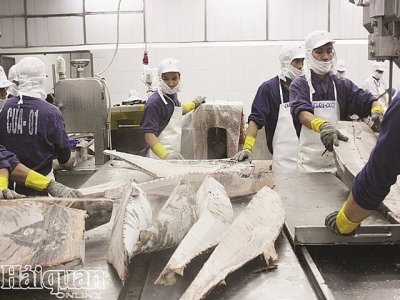Fisheries exports steep rise in markets

The Covid-19 epidemic has affected the export activity of fisheries enterprises. Exports to markets have declined, especially China.
Tuna items face a lack of raw materials. Photo: T.H
According to Vietnam Association of Seafood Exporters and Producers (VASEP), the Customs statistics till the end of February 2020, stated that the country’s fisheries exports reached more than US$991, reducing nearly 11% from the same period last year. The Covid-19 epidemic has affected production and export activities, especially China in the first two months, making export turnover to this market strongly decline by 44%, to EU by 20%, others such as ASEAN and South Korea by 4% and 9% respectively, compared to the same period last year.
The Covid-19 pandemic has been seriously affecting many economic areas, such as transportation, tourism, retail, stock market, and logistics, so fisheries import and export activities are unexceptional at least by the end of the first half of 2020. Not only China, but other markets have been also affected.
The closure of border gates by Covid-19 could reduce at least 20% of Vietnam’s fisheries exports to China in the first three months of the year.
Pangasius exports most affected
China is the largest import market of Vietnam’s pangasius, accounting for 35% of Vietnam's pangasius exports, so Covid-19 has had a great influence. The retailing system and supermarket stalled, the delivery system was congested, so exports to this market dropped sharply by 52% in the first two months of the year. Total Pangasius exports in the last two months reached US$210 million,down 32%. Not only China, but seafood exports to the US also decreased 27%, to the EU 40% and to ASEAN countries 19%.
According to some pangasius enterprises, in April, Pangasius exports to China could recover 50%, May 70%, and by June, it could recover 100%.
For the EU market, there has been an unclear impact on the first two months' results. However, Pangasius is mainly sold to retail system rather than the food service segment, so the EU market is an opportunity for the pangasius industry to recover, especially after the EVFTA takes effect.
In addition, the pangasius industry can take advantage of the fact that this year, pollock price increases, EU processing factories may consider to replace a part of white meat fish with pangasius if Vietnam enhances communication and promotion to change the impression of Pangasius on the EU market to be able to compete with Pollock and replace a part of white fish material when the import duty is reduced from 5% to 0%.
In addition, if pangasius products arecontrolled and promoted processing of value added goods, they can still have good prices inthe EU market, when the consumption channel in some markets recover.
Shrimp exports have not been affected
VASEP said that shrimp items have not been affected by the Covid-19 epidemic. By the end of February, shrimp exports still increased slightly 2.6%, reaching US$383 million, mainly thanks to the stable Japanese market, up 16%, while exports to China decreased 37%, to the EU decreased 15%.
In the US market, the transaction demand focuses on the supermarket segment, but now Indian and Ecuadorian shrimp are also exported to the US at a large volume and at lower prices, because they cannot be exported to China, so Vietnamese shrimp enterprises find it hard to buy raw shrimp at reasonable prices to compete with Indian and Ecuadorian shrimp.
Exports to China have been most affected by the serious epidemic. Enterprises are waiting and hope that in April, shrimp exports to China will recover and will focus on official exports by sea.
The current time is not the main season, shrimp material is insufficient,enterprises cannot buy shrimp at the desired price. In this situation, the shrimp industry waits for the recovery of key markets.
The Covid-19 epidemic has also strongly affected the export production of seafood enterprises. Many seafood enterprises now only work in moderation to maintain jobs for employees, because many export orders are reduced or canceled. Seafood exports in the first two months of 2020 decreased 7%, the largest drop was squid, octopus and tuna, mainly due to the lack of raw materials for export processing.
For the EU market, although seafood exports to this market account for 9% of the market share of exploited seafood exports, the demand is still high. Tuna material in the world is scarce due to poor catches and rising raw material prices. Currently, enterprises have to expand the scope of seeking more raw materials to other countries and regions to increase sources of input materials.
Many enterprises are affected by many shipping lines narrowing the number of ships and skipping trips, so the journey of ships to Vietnam or from Vietnam to other countries (including to the US or EU) affects the delivery of enterprises. Some shipping lines announced change of transshipment port, increase in freight rates and change of schedules.
According to VASEP, at present, the demand for seafood tends to decrease in the markets of China, the US and South Korea, only Europe has a high demand for the canned food segment. Some enterprises are turning to production of canned food because they have captured European demand trends and incentives from the EVFTA.
Có thể bạn quan tâm
Phần mềm

Phối trộn thức ăn chăn nuôi

Pha dung dịch thủy canh

Định mức cho tôm ăn

Phối trộn phân bón NPK

Xác định tỷ lệ tôm sống

Chuyển đổi đơn vị phân bón

Xác định công suất sục khí

Chuyển đổi đơn vị tôm

Tính diện tích nhà kính

Tính thể tích ao hồ



 Seafood exporters lose half of all orders to…
Seafood exporters lose half of all orders to…  A Guide to Recirculation Aquaculture - Part 9
A Guide to Recirculation Aquaculture - Part 9